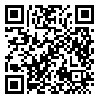Volume 13, Issue 52 (2020)
LCQ 2020, 13(52): 65-109 |
Back to browse issues page
Download citation:
BibTeX | RIS | EndNote | Medlars | ProCite | Reference Manager | RefWorks
Send citation to:



BibTeX | RIS | EndNote | Medlars | ProCite | Reference Manager | RefWorks
Send citation to:
Hosseini Moghadam A, Bameshki S, Ghavam A. From Love to Mysticism: The Analysis of Narrative Transformations and Change of Characters from Khosrow and Shirin by Nezami Ganjavi to Shirin and Farhad by Salimi Jerouni. LCQ 2020; 13 (52) :65-109
URL: http://lcq.modares.ac.ir/article-29-43884-en.html
URL: http://lcq.modares.ac.ir/article-29-43884-en.html
1- PhD student of Persian language and literature, Ferdowsi University of Mashhad
2- Assistant Professor of Persian Language and Literature Department, Ferdowsi University of Mashhad , bameshki@um.ac.ir
3- Associate Professor, Department of Persian Language and Literature, Ferdowsi University of Mashhad
2- Assistant Professor of Persian Language and Literature Department, Ferdowsi University of Mashhad , bameshki@um.ac.ir
3- Associate Professor, Department of Persian Language and Literature, Ferdowsi University of Mashhad
Abstract: (2577 Views)
Shirin and Farhad by Salimi Jerouni, composed in the ninth century AH, is adapted from Khosrow and Shirin by Nizami Ganjavi. The distinguishing feature of this poem is the addition of a mystical theme, as compared to its hypotext. The purpose of the current study was to investigate how the narrative structure of this poem has changed compared to Nizami Ganjavi’s Khosrow and Shirin, employing Gerard Genette’s theory of hypertextuality and also intentional interpretation. The researchers have also tried to show how Salimi Jerouni was able to connect his mystical thoughts with Khosrow and Shirin’s earthly love. Based on epitext and peritext analysis and through retrieval of the intention of the author, it was concluded that Salimi Jerouni had created a narrative, using quantitative transformation and pragmatic transformation that in its deep structure, illustrated mystical behavior. The characters of the story have gained symbolical interpretation, proportional to the mystical content of the poem and in line with the evolution of the hero (Khosrow) on the way of reaching the position of a perfect man.
Article Type: Original Research |
Subject:
Narrative Science
Received: 2020/06/22 | Accepted: 2020/11/25 | Published: 2020/12/30
Received: 2020/06/22 | Accepted: 2020/11/25 | Published: 2020/12/30
Send email to the article author
| Rights and permissions | |
 |
This work is licensed under a Creative Commons Attribution-NonCommercial 4.0 International License. |









